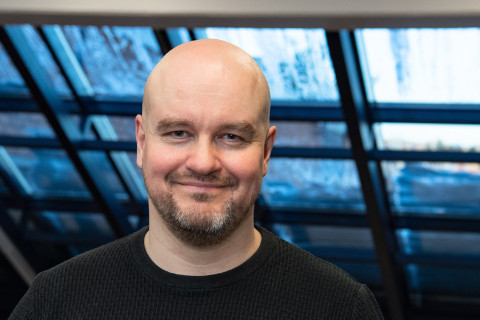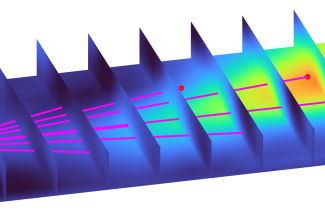Inverse problems refer to mathematical problems that cannot be solved in a straightforward manner; instead, solving them requires a broad range of methodological expertise, says Professor Aku Seppänen.
In Finland, research into inverse problems has been conducted for about three decades, and the Finnish scientific community is recognised as a global leader in the field. The Academy of Finland granted funding for the Centre of Excellence in Inverse Modelling and Imaging for 2018–2025, and the University of Eastern Finland is a partner in this centre.
“Research into mathematical modelling and inverse problems is constantly providing new methods for, e.g., applied physics. Physics, on the other hand, is everywhere around us – its applications can be found in the cell phones we carry around in our pockets, in the imaging devices used in medicine, and in environmental monitoring carried out from satellites, aeroplanes and the ground,” says Professor Aku Seppänen.
Measurements conducted by scientists and engineers do not always provide direct information on the phenomenon that is being investigated. In these cases, computational methods and inverse mathematics can help to determine the quantities that are descriptive of the phenomenon.
“In this area, you really get to use your mathematical skills; the opportunities are endless.”
Seppänen’s research group is developing new measurement techniques and related computational methods needed for various applications. One such application is for monitoring the condition of concrete structures on the basis of measurements taken from the surface – without breaking the concrete.
“It is not easy to see inside concrete, at least not without drilling a hole in it. However, this can be done, thanks to electrical surface measurements and inverse mathematics applied to the analysis of the measurement data.”
Another research topic close to Seppänen’s heart is related to environmental monitoring. He is currently conducting research in close collaboration with aerosol physicists. Their research will lead to novel computational methods that provide new information on aerosol particles.
“The aim is to determine the mechanisms and rates at which atmospheric aerosol particles are formed, grown and deposited. All of this cannot be measured directly but has to be determined from indirect measurement data using computational inverse methods.”
Understanding the behaviour of atmospheric aerosols is extremely important, as these particles affect both human health and global warming in many ways.”
Another goal of Seppänen’s research group is to determine the greenhouse gas balance of agriculture. Arable crops either emit or remove greenhouse gases from the atmosphere at different stages of the growing season. Cultivation practices, such as fertilisation and ditching, affect the emission and removal of greenhouse gases.
“We are collaborating with researchers at Natural Resources Institute Finland to develop new technologies for measuring the impact of different cultivation practices on the greenhouse gas balance,” Seppänen says.
There will be errors in the interpretation of the data if uncertainties are ignored
Seppänen’s interest in data analysis and inverse problems sparked when he was studying physics as an undergraduate at the University of Kuopio. At that time, he realised that mathematical methods can be used in the processing of all kinds of measurement data.
“Suddenly systems of equations, derivatives and probability densities – everything I had been enthusiastic about since general upper secondary school without knowing if it’d ever be useful – seemed to have unlimited applications in the real world. That’s when I realized I was studying the right thing and at the right place.”
“Or, as the kids say, I was like OMG!” Seppänen says, laughing, but dead serious.
“Research into inverse problems is progressing rapidly at the moment, and new areas of application that benefit from this development are constantly being included. In many areas, mathematical modelling and measurements have previously been separate from one another. Inverse computation creates a link between them.”
Indeed, research into inverse problems is multidisciplinary and its applications require dialogue between theoreticians, modellers, measurers and application users. One of the most decisive factors for the reliably of, e.g., medical imaging or remote sensing technology is whether all uncertainties related to the measurement situation have been taken into account in the mathematical modelling used for analysing the measurement data.
“Uncertainties, such as those related to the operation of a device or its usage environment, have a major impact on how reliable the technology is. There will be errors in the interpretation of the data if we fail to consider all variables.”
“It goes without saying that understanding of these factors does not arise in ivory towers or in isolated offices of computationally oriented researchers; instead, understanding arises from the modeller understanding what the measurer does, and the measurer understanding the limitations of the models.”
Results obtained using imaging and remote sensing methods have been improved by taking measurement-related uncertainties into consideration in modelling. Another important point pertains to analysing the reliability of quantities determined on the basis of measurements. An analysis using mathematical modelling and statistical methods also tells its user about the reliability of the results.
“A result given by a measuring device – be it a single reading or, for example, a 3D image or a hologram depicting the internal humidity distribution in concrete – does not really tell the user anything, unless it also provides information on how reliable the result is,” Seppänen says, sighing.
At the end of the interview, the newly appointed professor extends his thanks to the junior members of his research group, and to the teaching staff of the Department of Applied Physics at the University of Eastern Finland.
“The fact that I’ve always had many unbelievably talented people under my supervision has been an important factor in my career. Without them, none of this would have been possible. All lecturers and other teaching staff at our department are also to be thanked for this. It is to a great extent thanks to their work that, year after year, I get to supervise really talented, aspiring researchers.”
For further information, please contact:
Professor Aku Seppänen, tel. +358 40 740 5624, [email protected],
Print-quality photos photo1, photo2, photo3
***
Aku Seppänen, Professor of Inverse Problems and Modelling of Uncertainties in Environmental Monitoring, University of Eastern Finland, 1 January 2022–
Degrees
MSc, University of Kuopio, 2000
PhD, University of Kuopio, 2006
Title of Docent in Applied Inverse Problems, University of Eastern Finland, 2011
Key roles
Associate Professor, Big Data and Uncertainty Modelling in Climate Change, University of Eastern Finland, 2018–2021
Academy Research Fellow, University of Eastern Finland, 2013–2018
Academy of Finland Postdoctoral Researcher, University of Eastern Finland, 2011–2013
Researcher/ Project Researcher/ Senior Researcher, University of Kuopio and University of Eastern Finland 2006–2010
Selected research projects (PI or co-PI role):
Centre of Excellence in Inverse Modelling and Imaging (funded by the Academy of Finland) 2018–2025.
Tomography in the Field – New Monitoring Method for the Effects of Farming Management on the Greenhouse Gas Balance in Agriculture (funded by the Regional Council of North Savo) 2021–2023.
Science for Clean Energy, Horizon 2020 project (coordinated by University College London, funded by the European Commission), 2017–2020.
Four-dimensional Remote Sensing – Standardizing Airborne Laser Scanning Data through Space and Time (funded by the Academy of Finland), 2016–2017.




